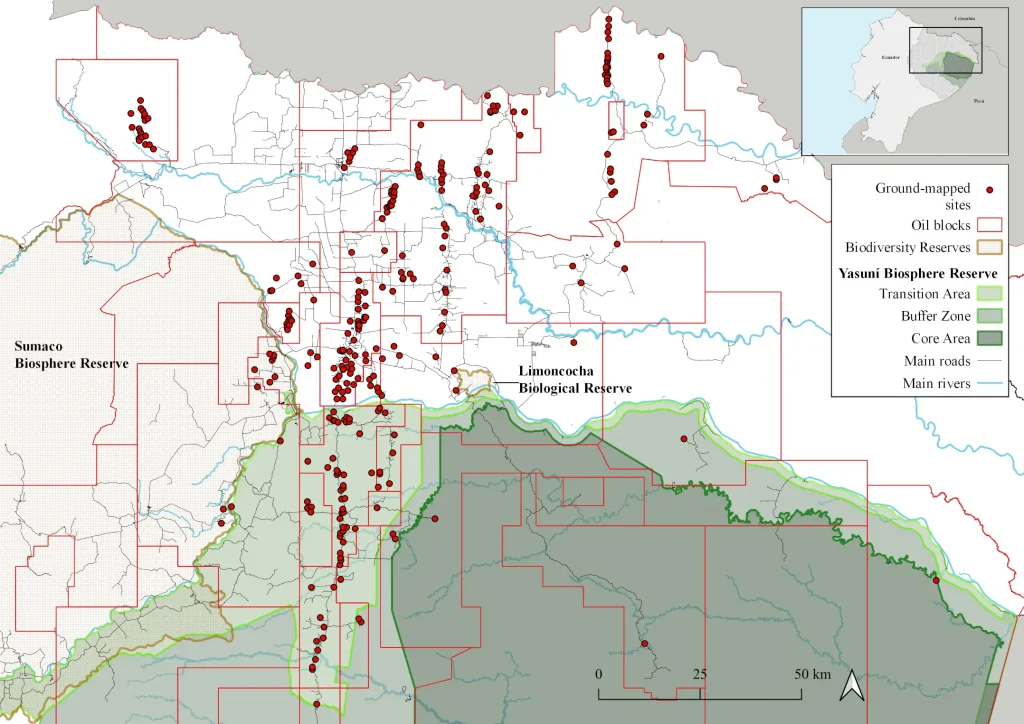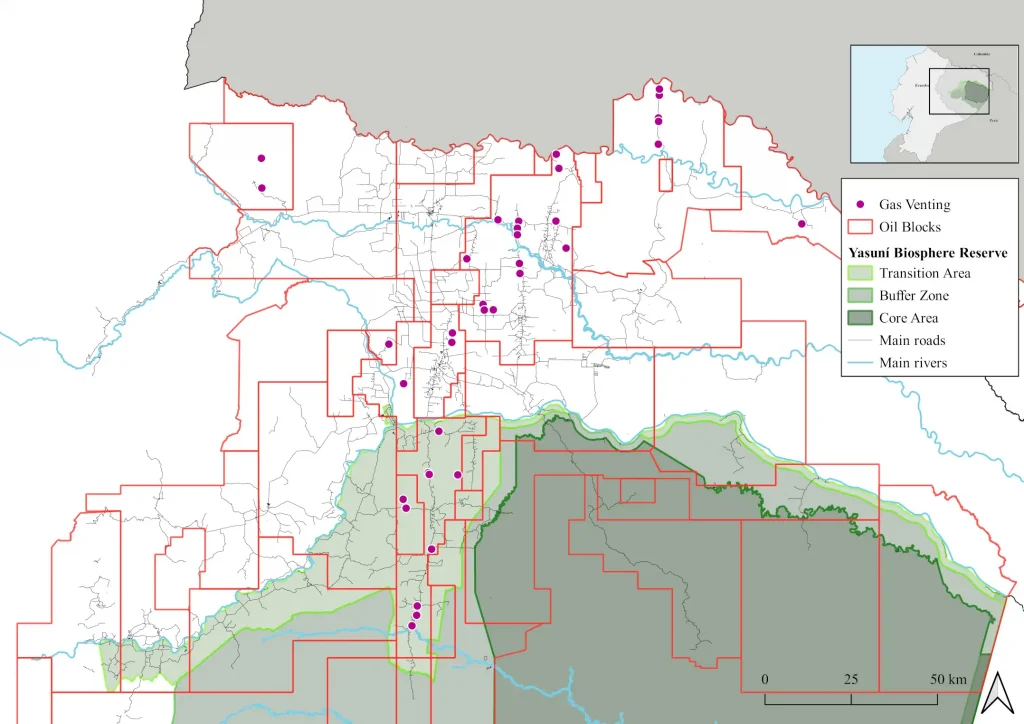25 February 2022 – Press release | Downlad pdf
Authors: Francesco Facchinelli, Salvatore Eugenio Pappalardo*, Giuseppe Della Fera, Edoardo Crescini, Daniele Codato, Alberto Diantini, Donald Moncayo, Pablo Fajardo, Elisa Bignante, Massimo De Marchi
*corresponding author, email: salvatore.pappalardo@unipd.it
On January 21, 2022 was published on the open access journal Environmental Research Letters the paper Extreme citizens science for climate justice: linking pixel to people for mapping gas flaring in Amazon rainforest. The paper is available also in Spanish in the web page of the Climate Justice – Centre of Excellence Jean Monnet.
The study, carried on from the research group Climate Change, Territories, Diversities of the ICEA Department of the University of Padova and the Union de Los Afectados Para Texaco, was born in the frame of the campaign Apaguen Los Mecheros, Enciendan La Vida!.
The paper reports the Extreme Citizen Science process which allowed to map 295 gas flaring sites (Figures 1 and 2) for a total of 437 stacks in the Ecuadorian Amazon, creating data and cartographies which were included in the demand for a Protection Action presented from nine children and supported from the campaign Apaguen Los Mecheros, Enciendan La Vida! After more than one year the Court of Sucumbíos, issued an historical order to ban gas flaring activities in the Ecuadorian Amazon on January 26, 2021.
This legal victory underscores the role that joint efforts between scientific research and local communities – as research goals remain linked to their real needs by supporting their struggles for local environmental justice – can foster policy changes in the respect of human and nature’s rights, toward a more climatic just world.



By adopting a participatory approach, this study provides the first dataset independent and ground-validated on gas flaring activities. The results confirm that gas flaring activities are widespread in the Ecuadorian Amazon Region, with implications for biodiversity conservation, human rights protection and policy-making. The map of the gas flaring sites is available online in the website of the Climate Justice – Centre of Excellence Jean Monnet. It is still possible contribute to the mapping of gas flaring sites, as well as follow its evolution in real time.
This work represents the first attempt to monitor gas flaring activities by combining remote sensing-based methods with a participatory, citizen science approach to develop a ground validated dataset on a regional Amazonian scale, Furthermore, this study describes a participatory mapping process based entirely on free and open-source Geographical Information Systems (GIS) technologies for the implementation of low-cost environmental monitoring that is economically sustainable for NGOs and researchers.
The reported data highlight for the first time the true extension of gas flaring activities in Ecuador, showing 198 sites more the Ministry of Environment and 223 more than the ones detected by the Nightfire algorithm through the elaboration of imagery from the Suomi-NPP imagery. Of the identified sites, 75 were in the UNESCO Biosphere Reserve and 3 in its Core Area (Figure 2 and Table 1).


| Gas flaring sites | Stacks | Active Stacks | |
|---|---|---|---|
| Ecuadorian Amazon Region | 295 | 437 | 280 |
| Sucumbíos Province | 135 | 204 | 115 |
| Orellana Province | 155 | 228 | 162 |
| Napo Province | 2 | 2 | 2 |
| Pastaza Province | 3 | 3 | 1 |
| Yasunì Biosphere Reserve | 75 | 103 | 69 |
| Core area | 3 | 3 | 3 |
| Buffer Zone | 5 | 5 | 4 |
| Transition Area | 67 | 95 | 62 |
Gas flaring activities have important impacts both on a local and a global scale. In 2019, the reported amount of flared gas worldwide was 150 Billion Cubic Metres (BCM), the highest level over ten years (World Bank, 2020). Moreover, estimated gas flaring emissions include about 400 Mt every year of CO2 equivalent and 230 Mt every year of black carbon, representing about 1% and 4% of global anthropogenic emissions, respectively (Caseiro et al., 2020; Quéré et al., 2018; Weyant et al., 2016; World Bank, 2020). Gas flaring emissions in Ecuador are estimated to amount for approximately 1 BCM every year, comprising 8% of Ecuador’s total Nationally Determined Contributions, the country’s target level emissions agreed upon through the Paris Climate Agreement (Elvidge et al., 2018).
Local impacts of gas flaring affect ecosystems, biodiversity, and local communities, and include changes in microclimate, acid rains, alteration of physiochemical properties of soil, rainwater and air, direct emission of more than 250 identified toxins, and decrease in crop yields (Ismail and Umukoro, 2012; Obi and Osang, 2015; Onuoma et al., 2015; Ozabor and Obisesan, 2015; Uyigue and Enujekwu, 2017).
Moreover, the participatory mapping process supported by organizations with local knowledge, allowed for the identification for the first time in Ecuadorian Amazon, of 39 sites which were venting the gas directly in the air instead of flaring; this activity is “invisible” to satellite sensors and can easily be confused with inactive stacks during data collection (Figure 3). It should be noted that gas venting has more severe environmental impacts than flaring, in particular on climate change, as it causes the emission in the atmosphere of methane. This gas has a global warming potential 86 times higher than CO2, in which it is usually converted in the flaring process (Hendrick et al., 2017).


Finally, it is worth noting that around flare stacks, particularly the largest ones, a significant number of dead insects were detected. This causes particular concern, given that the region is a global diversity hotspot for insects (Bass et al., 2010). These results highlight the need for further research in order to identify and quantify the impacts of gas flaring in the Ecuadorian Amazon, and in other Amazonian sectors. Future research should focus on the development of a continuous monitoring system and field studies to measure chemical emissions, and to identify place-specific impacts that account for local, social, and environmental conditions.
References
Bass, M.S., Finer, M., Jenkins, C.N., Kreft, H., Cisneros-Heredia, D.F., McCracken, S.F., Pitman, N.C.A., English, P.H., Swing, K., Villa, G., Di Fiore, A., Voigt, C.C., Kunz, T.H., 2010. Global Conservation Significance of Ecuador’s Yasuní National Park. PLoS One 5, e8767. https://doi.org/10.1371/journal.pone.0008767
Caseiro, A., Gehrke, B., Rücker, G., Leimbach, D., Kaiser, J.W., 2020. Gas flaring activity and black carbon emissions in 2017 derived from the Sentinel-3A Sea and Land Surface Temperature Radiometer. Earth Syst. Sci. Data 12, 2137–2155. https://doi.org/10.5194/ESSD-12-2137-2020
Elvidge, C.D., Bazilian, M.D., Zhizhin, M., Ghosh, T., Baugh, K., Hsu, F.C., 2018. The potential role of natural gas flaring in meeting greenhouse gas mitigation targets. Energy Strateg. Rev. 20, 156–162. https://doi.org/10.1016/j.esr.2017.12.012
Hendrick, M.F., Cleveland, S., Phillips, N.G., 2017. Unleakable carbon. Clim. Policy 17, 1057–1064. https://doi.org/10.1080/14693062.2016.1202808
Ismail, O.S., Umukoro, G.E., 2012. Global Impact of Gas Flaring. Energy Power Eng. 4, 290–302. https://doi.org/10.4236/epe.2012.44039
Obi, E.O., Osang, J.E., 2015. Thermal Effects of Gas Flaring Activities in Ogba-Egbema-Ndomi Community, Rivers State, Nigeria. Int. J. Energy Environ. Res. 3, 1–11.
Onuoma, O.J., Alex, O.I., Olawale, O.O., Adekanmi, A.A., 2015. The Environmental Implication of Gas Flaring in Sapele Community of Delta State, Nigeria. Int. J. Oil, Gas Coal Eng. 3, 60. https://doi.org/10.11648/j.ogce.20150305.11
Ozabor, F., Obisesan, A., 2015. Gas Flaring: Impacts on Temperature, Agriculture and the People of Ebedei in Delta State Nigeria. J. Sustain. Soc. 4, 5–12. https://doi.org/10.11634/216825851504752
Quéré, C., Andrew, R., Friedlingstein, P., Sitch, S., Hauck, J., Pongratz, J., Pickers, P., Ivar Korsbakken, J., Peters, G., Canadell, J., Arneth, A., Arora, V., Barbero, L., Bastos, A., Bopp, L., Ciais, P., Chini, L., Ciais, P., Doney, S., Gkritzalis, T., Goll, D., Harris, I., Haverd, V., Hoffman, F., Hoppema, M., Houghton, R., Hurtt, G., Ilyina, T., Jain, A., Johannessen, T., Jones, C., Kato, E., Keeling, R., Klein Goldewijk, K., Landschützer, P., Lefèvre, N., Lienert, S., Liu, Z., Lombardozzi, D., Metzl, N., Munro, D., Nabel, J., Nakaoka, S.I., Neill, C., Olsen, A., Ono, T., Patra, P., Peregon, A., Peters, W., Peylin, P., Pfeil, B., Pierrot, D., Poulter, B., Rehder, G., Resplandy, L., Robertson, E., Rocher, M., Rödenbeck, C., Schuster, U., Skjelvan, I., Séférian, R., Skjelvan, I., Steinhoff, T., Sutton, A., Tans, P., Tian, H., Tilbrook, B., Tubiello, F., Van Der Laan-Luijkx, I., Van Der Werf, G., Viovy, N., Walker, A., Wiltshire, A., Wright, R., Zaehle, S., Zheng, B., 2018. Global Carbon Budget 2018. Earth Syst. Sci. Data 10, 2141–2194. https://doi.org/10.5194/essd-10-2141-2018
Uyigue, L., Enujekwu, M., 2017. Physicochemical Analysis of Gas Flaring Impact on the Environment of Host Communities in the Niger-delta. J. Environ. Pollut. Hum. Heal. Vol. 5, 2017, Pages 22-29 5, 22–29. https://doi.org/10.12691/JEPHH-5-1-4
Weyant, C.L., Shepson, P.B., Subramanian, R., Cambaliza, M.O.L., Heimburger, A., McCabe, D., Baum, E., Stirm, B.H., Bond, T.C., 2016. Black Carbon Emissions from Associated Natural Gas Flaring. Environ. Sci. Technol. 50, 2075–2081. https://doi.org/10.1021/acs.est.5b04712 World Bank, 2020. Global Gas Flaring Jumps to Levels Last Seen in 2009 [WWW Document]. URL https://www.worldbank.org/en/news/press-release/2020/07/21/global-gas-flaring-jumps-to-levels-last-seen-in-2009 (accessed 12.10.20).



